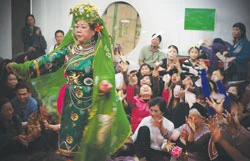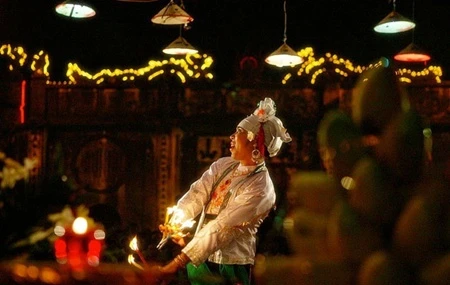Researchers have been working to find a way to protect and preserve authentic hau dong, a medium ritual used in the northern religion of Dao Mau, which worships the Vietnamese deity of Mother Goddess.
Researchers and practitioners of the religion are working on developing a dossier to submit to UNESCO for a World Intangible Heritage recognition.
Hau dong is a ritual used to connect to the spirit Mother Goddess (Dao Mau) and other deities, to whom they communicate their concerns and prayers for good health and fortune. Worshippers and followers of the Dao Mau religion come from all parts of society, though the practice of hau dong was banned during the war time, but restrictions on its practice were only eased about a decade ago.
There are many who regard the practice as a superstition, but cultural scholars argue that hau dong is a special feature of traditional and native Vietnamese culture and needs to be preserved as authentically as possible.
Recently worries have circulated about hau dong performers loosing touch with the heritage of the practice, some medium performers faking it or not knowing proper methods and therefore degrading its value.
Followers perform hau dong and hat van (spiritual singing) to entertain and praise deities. During the performance, they dress up like the deities they sing for.
Luu Ngoc Duc, a keeper of Lanh Giang Vong Tu Temple in Hoan Kiem district, has followed Mother Goddess belief and hau dong for 30 years.
He spoke of being shocked by a performance at Rung (Forest) Temple in Long Bien district in which a medium plays the role of Lady Bo, but this time the performer wore a 5m-long dress.
"As the legend says, Lady Bo was born in the rural area," said Duc, explaining, "She was devoted to helping King Le Loi (1385-1433) and his army fight against the Chinese Ming invaders."
Lady Bo hid the king in a maizefield and had to row a boat leading the soldiers to safety, that's why a performer in her role should have worn a tight dress, said Duc.
"The performer often holds a pair of oars in the hau dong piece to serve Lady Bo. I wonder, how can she ride a boat in such a long dress?" he said.
"Many practitioners want to make the performance brilliant and impressive but they make everything non-sense. They don't understand or may have forgotten the belief they follow," he said.
"Outfits are based on folk belief and have existed for a long time among followers," Duc said, adding that he felt sad to see many performers confusing deities' costumes.
Researcher Ngo Duc Thinh, former Director of the Vietnam Institute of Cultural Studies, acknowledged the confusion arising in hau dong practice, not only with costumes but also with the performance.
"Many costumes have changed so much that audiences can't recognize which deities they belong to," said Thinh.
Some hat van singers perform incorrect songs and some perform folk songs adopted from Laos and Thailand just because they have similar melodies to original ceremonial songs, he explained.
"Before, a band of van singers consisted of two or three people," said Thinh, "now a band can reach to five or six people with many musical instruments."
"I believe such a large band can spoil the holy atmosphere at temples, which is quite small and not suitable for loud music," said Thinh.
Many conferences have been organised in the past decade to protect the Mother Goddess religion and hau dong performance. Above all, followers want to preserve it because they want to practice, perform and introduce their heritage to other people, Thinh said.-VNA























